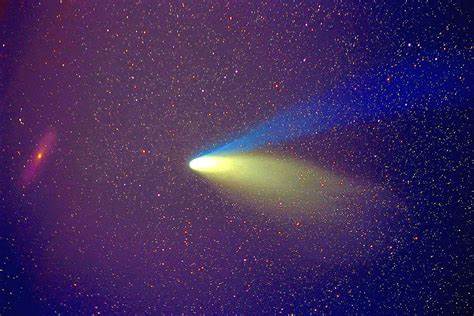This year, scientists have had a chance to study something pretty mind-boggling:
今年,科学家有机会研究很难以想象的东西:
a comet that came from outside of our solar system.
来自太阳系外的一颗彗星。
The comet appeared this summer, and on December 8th, it made its closest approach to the Sun.
这颗彗星是在夏季出现的,12月8日是这颗彗星距离地球最近的时候。
It's called 2I/Borisov, and it's only the second interstellar object we've ever detected.
这颗彗星名为2I/Borisov,这是我们观测到的唯二的星际物体。
The second interstellar interloper, if you will.
也可以称它为天外来客。

It's traveled billions of kilometers to get here, and so long as it's in our neighborhood, there's a lot we can learn from it about regions of space far beyond our own.
这颗彗星穿梭了数十亿千米才得以抵达那里,虽然它在我们临近的地方,但我们依然可以通过它来了解太阳系的空间区域。
In fact, there's a lot we're already learning.
实际上,我们已经了解了很多。
Last week, NASA released a shiny new image of the comet, and over the last few weeks, scientists have published a handful of new papers about it.
上周,美国宇航局(NASA)发布了这颗彗星一张闪闪的新图片。在过去几周的时间里,科学家发布了关于这颗彗星的许多新论文。
And so far, all this research is demonstrating that 2I/Borisov is full of surprises.
目前为止,所有这些研究都证明这颗彗星充满让人惊奇的地方。
The comet was discovered this August by a Crimean telescope engineer named Gennady Borisov.
这颗彗星是今年8月由克里米亚的某望远镜工程发现的,该工程师名为鲍里索夫。
Who, for the record, discovered this comet using a telescope he built himself!
历史上有水是用自己建造的望远镜发现这颗彗星的呢!
I have a hard time building IKEA furniture. After Borisov saw the object, he submitted his findings to the astronomy community so more researchers could take a look.
我费了好大的劲儿才打造出宜家的家具。在鲍里索夫看到了这个物体后,他将自己的发现成果提交给了天文学社群,这样更多的科学家能瞅一瞅。
And ultimately, everyone's early data indicated that something was super weird.
最终,每个人早期的数据都表明有些地方怪怪的。
For one, this comet had a very weird orbit.
一方面,这颗彗星的轨道很奇怪。
Most objects around here travel in a closed loop around the Sun, but 2I/Borisov seemed to have a highly hyperbolic orbit.
这附近的大多数物体都在太阳附近做闭环运动,但这颗彗星似乎有一个很夸张的轨道。
In other words, it wasn't actually orbiting the Sun.
换言之,其实它并不是绕着太阳环行的。
Instead, it was on a path that would swing around our star and then zoom off into the distance, never to return.
相反,它所环绕的轨道一开始会离地球很近,随后又越来越远,一去不复返。
Now technically, it is possible that something within our solar system could get bumped into an orbit like that.
理论上来说,有可能太阳系内的什么东西会进入这样的轨道。
There's even some evidence of this happening on a smaller scale way out in the Oort Cloud beyond Pluto.
甚至有证据表明这种现象在冥王星外的奥尔特云小规模地发生着。
But 2I/Borisov was traveling on a path that was dramatically tilted compared to the rest of our neighborhood.
不过,该彗星所行进的路径与我们附近的其他物体相比发生了极度的倾斜。
It also seemed to be moving especially fast, at more than 30 kilometers per second.
而且,该彗星的速度似乎极快,达到了30km/s。
So, with that kind of speed and orbit, well, scientists eventually concluded that this thing wasn't from around here.
所以,鉴于其拥有这样的速度并且在这样的路径上运动,所以科学家最终得出的结论是:这颗彗星并不是来自于这附近。
We mentioned this discovery on SciShow Space in late September, but since then, scientists have been observing 2I/Borisov as much as possible.
这个发现,我们曾在9月末的节目中提到过。不过,从那时起,科学家就在尽可能多地观测这颗彗星。
And some of their results have been published over the last few days or weeks.
他们的一些成果于过去几天或者几周内得到了发表。
Using images from various ground and space telescopes, these researchers have characterized every aspect of the comet they could.
通过不同地面和空间望远镜传回的图像,这些科学家已刻画出这颗彗星每方面的特征。
They've calculated its size and shape, the rate it's losing mass, and how it reflects light in different wavelengths, something that can tell us about its composition.
他们计算了这颗彗星的大小和形状、损失质量的速率、反射不同波长光的方式,这些信息都能帮助我们了解这颗彗星的组成。
So, now we know a few things. Like, the data show that the comet's body, called the nucleus, is less than 500 meters across.
所以,现在我们手头已经有一些信息了。比如,数据显示,这颗彗星的主要部分,也就是核心小于500米。
And they also show that its dust tail, or coma, has a similar composition to some comets from the Oort Cloud.
数据嗨显示,尘埃彗尾,也就是彗形像差,其组成跟奥尔特云的一些彗星相似。
In fact, based on these results, if this comet had come from inside our solar system, it would be pretty unremarkable. Which that's actually kind of remarkable.
实际上,根据这些数据得到的结果:如果这颗彗星是来自太阳系内,那么就太棒了。
Especially if you compare this comet to the only other interstellar visitor we know of:
尤其是把这颗彗星跟我们目前所知的其他天外来客相比。
Oumuamua, which zoomed past us in 2017.
2017年,奥陌陌经过我们。
With its probably cigar-like shape and shiny surface, Oumuamua was among the weirdest objects anyone had ever seen.
奥陌陌形状像雪茄,表面闪光,是目前所知的最怪异的物体之一。
So, how come 2I/Borisov looks so normal, even though they're both from interstellar space?
那么,同样都是来自星际,为何2I/Borisov看起来这么正常呢?
Well, we don't know, and it's way too early to make generalizations.
Emmm,这个嘛,我们目前也不知道,现在下定论还为时尚早。
The most we can say from these 2 data points is that the 2 objects seem to come from 2 different spots.
从这2条数据,我们可以得知,这2个物体似乎来自2个不同的地方。
By working back from their current trajectories, scientists think 2I/Borisov came from the general direction of the constellation Cassiopeia.
通过研究他们当前的轨道,科学家认为,这颗彗星大体来自于仙后座的方向。
Meanwhile, Oumuamua likely came from somewhere in the direction of the star Vega.
与此同时,奥陌陌很有可能来自织女星方向的某处。
So maybe that explains some of the differences. But also, let's be honest: 2 data points representing all interstellar objects...
所以,或许这个信息能解释他们的一些差异。不过,不能忽视的是:这2个条信息代表的是所有星际物体……
It's just not a lot to go on. As telescopes get better and better at resolving faint objects,
所以,信息量目前还不够充足。随着望远镜解析模糊物体的能力越来越强,
we may have better luck at making more discoveries like this.
我们或许能有幸有个更多类似的发现。
But until then, we'll be left with more questions than answers.
不过,等到那时候,我们的问题还是比答案多的。
The good news is, one way or another, we are not done with 2I/Borisov yet!
好消息是:不管怎样,2I/Borisov的谜团还没彻底解开呢!
While we only saw Oumuamua on its way out of the solar system, we caught 2I/Borisov while it was sill coming in, so we have more time to observe it.
虽然我们看到奥陌陌的时候,它正往太阳系外走。但2I/Borisov现在是正在进太阳系的过程中,所以我们有更多时间可以观察2I/Borisov。
It will be making its closest approach to Earth around December 28th, so we'll be able to study it with the best precision yet.
12月28日是2I/Borisov离地球最近的时候,也是我们可以最精确研究它的时候。
And that means there will be plenty more to learn about our second visitor from interstellar space.
这就意味着,我们对于天外来客可以了解的就更多了。
Thanks for watching this episode of SciShow Space News!
感谢收看本期的《太空科学秀》!
As December winds down, we wanted to remind you about our Pin of the Month club.
12月正悄然离去,我们想提醒大家月度俱乐部的大头针。
Every month, we release a new space-themed pin that you can use to celebrate your love of exploration.
每个月,我们都会发布一个以空间为主题的大头针,供大家来庆祝对探索的热爱。
And this month, we've got one of an astronaut riding around on the Apollo 17 lunar rover!
这个月,我们有一名宇航员在阿波罗17月球探测器附近活动。
It was designed by one of the amazing animators on the SciShow team, and it's really just so good.
这是由我们节目组超级棒的一位动画师设计的,非常棒。
Also, it's a great chance to tell people about that one time we drove buggies on the Moon.
而且这也是个好机会,可以告诉大家我们在月球上使用探测器进行过活动。
If you want to get a pin for you or a friend, they're only available until the end of the month!
如果大家想为朋友赢得这样的大头针,请记得只有本月可以获得哦!
You can find them at DFTBA.com, or in the merch shelf below this video.
更多信息可在DFTBA.com上了解,也可以通过视频下方的描述来了解。











